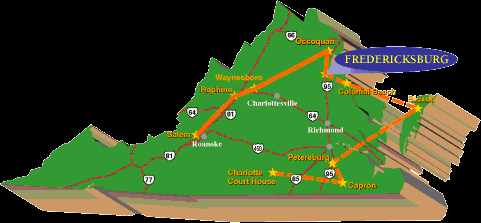
Download
in PDF Format
History is to Fredericksburg what
autumn leaves are to the Blue Ridge Parkway or the ocean is to Virginia
Beach.
It�s not the only reason to visit,
but it defines the region�s character and enhances all the other aspects
of a visitor�s experience.
|

Nestled
in the lush green landscape just off I-95, Fredericksburg is about
halfway between Richmond and Washington, D.C. |
If George Washington or James Monroe
were to return to Fredericksburg today, many of the buildings in a
40-block area of the city that is designated as a National Register
Historic District would look familiar. Some of those buildings also have
scars from an 1862 Civil War battle that included a devastating artillery
barrage and deadly house-to-house fighting. Visitors can stand where
Robert E. Lee watched from the heights south of town as his Confederate
troops delivered one of the most lopsided victories of the war.
Some local residents embrace their
town as �America�s Most Historic City.� But other places stake claim
to that title, as well. So, when a regional tourism group selected a brand
name in 2005, they settled on something simple and to the point:
�Fredericksburg Timeless.� The idea was to link the region�s rich
history with opportunities for shopping, dining, entertainment and
recreation. Think old-town charm sprinkled with modern-day conveniences.
|

While
visiting "timeless" Fredericksburg, you can learn about
Colonial medical practices at the Hugh Mercer Apothecary Shop. |
�We were seeking a brand that would
identify the unique selling points that the city has to offer and not
focus on just one thing,� says David Holder, the city�s director of
tourism and economic development. �We feel like we have a perfect
timeless mix of historic sites and modern amenities.
�This is a place you can visit and
be yourself � or be a kid again, if you like � and have fun any way
you choose. I think people can come here and escape the stress of life
today and lose track of time. And that�s important with so many busy
lifestyles.�
So far, the brand name seems to be
working. Statistics indicate that about 262,000 tourists visited
Fredericksburg�s attractions in 2005, while revenue from meals and
lodging taxes rose 8 percent over the previous year.
Location, location �
Fredericksburg sits roughly halfway
between Washington, D.C., and Richmond � about 50 miles from each via
Interstate 95 or U.S. 1. The city�s population is about 21,000 and it is
the hub of a fast-growing region that includes neighboring Spotsylvania,
Stafford, Caroline and King George counties.
Any discussion of the town probably
should begin with the Rappahannock River, which represents the city�s
northern border as it meanders from the Blue Ridge mountains toward the
Chesapeake Bay. Capt. John Smith explored the Rappahannock to present-day
Fredericksburg in 1608, but Native Americans were living in the region as
early as 7,000 B.C. Fishing for shad and herring is a popular spring
ritual that links past and present.
|
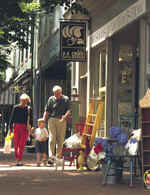
Beyond
its historical appeal, Fredericksburg offers a choice selection of
shopping and dining venues. |
Fredericksburg was established in 1728
and was named for Crown Prince Frederick, the son of George II of England.
Local historian Paula Felder writes that initially, the town �was a
tiny, raw, dusty river port with the same characteristics that we
associate with the later frontier towns of the West.�
George Washington came to live at a
family property across the Rappahannock from Fredericksburg in 1738 when
he was six years old. The site is called Ferry Farm � where legend says
young George was able to throw a coin across the river and could not bring
himself to tell a lie about cutting down a cherry tree. Washington�s
family has a strong connection to Fredericksburg and he was a frequent
visitor as an adult. His mother Mary, sister Betty and brother Charles all
lived in the city, and their former homes are among the city�s most
popular attractions today.
Another important historic site is the
James Monroe Museum and Memorial Library. Monroe came to Fredericksburg at
age 28 in 1787 and stayed for three years. He practiced law in
Fredericksburg and served on city council before moving to Albemarle
County on his way to national prominence.
The city continued to prosper into the
1800s, and in 1837, the Richmond, Fredericksburg and Potomac Railroad
reached as far north as Fredericksburg. According to historian Felder,
this was the beginning of the north-south transportation corridor that
would dominate the town�s future.
City under the guns
�Of all the Southern towns made
famous by blood, none would be more famous than Fredericksburg,� wrote
John Hennessy in an article last year for Blue & Gray magazine.
Hennessy is the chief historian for the Fredericksburg and Spotsylvania
National Military Park.
|
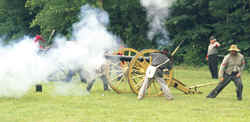
Cannon
fire still rings in the historical hamlet, where the Civil War's
imprint remains vivid. |
�No community in America suffered
longer or more variously at the hands of civil war; its wartime ordeal
started as inconvenience and affront, but ended amidst horror, poverty and
death � More than a century later, the Civil War remains
Fredericksburg�s central event � a defining epoch whose imprint
remains vivid and visible.�
The city became a killing ground in
December 1862, when Union Gen. Ambrose Burnside tried to dislodge Lee�s
Army of Northern Virginia from the heights south of town. First, he had to
eliminate Confederate sharpshooters who were preventing his men from
constructing pontoon bridges across the
Rappahannock. To do that, he directed
an artillery barrage that laid waste to the town. Frustrated by tenacious
street fighting once they did cross the river, the Federals went on a
destructive looting spree as most of the remaining civilians tried to
escape through Confederate lines.
On Dec. 13, Burnside struck Lee at two
points. But Gen. Thomas J. �Stonewall� Jackson�s men held firm on
the Confederate right flank and the Rebels of Gen. James Longstreet
slaughtered the Federals during their repeated attempts to capture
Marye�s Heights. When silence finally fell over the battlefield, the
Federals had suffered more than 12,000 casualties, compared to about 5,000
for the Confederates.
Three more major Civil War battles �Chancellorsville,
Wilderness and Spotsylvania Court House � were fought within 20 miles of
Fredericksburg during 1863 and 1864. Combined, these
engagements involved more than 750,000 men and produced 100,000
casualties. The economic impact of the Civil War on the civilian
population can�t be overstated. It was the 1940s before census figures
in the region reached pre-war levels.
|
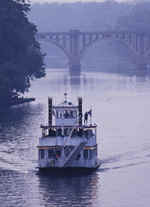
While
visiting Fredericksburg, board a 100-foot paddle boat for a cruise
on the Rappahannock River. |
In a column marking the anniversary of
Lee�s birthday last January, local newspaper editor Ed Jones wrote,
�With historic preservation and Civil War tourism very much in the
headlines, this area can claim a wonderfully mixed identity: a growing
outpost of Washington where the War Between the States is still a breaking
news story.�
A flourishing community
Despite its historical legacy,
Fredericksburg today is anything but a stale and sleepy town.
The Old Town section offers an
inviting mix of antique stores, art galleries, specialty shops and
restaurants. A new parking garage nearby is a nice convenience, and plans
for a modern downtown hotel are on the drawing board.
The city�s chief commercial engine
these days is Central Park, which is located just off I-95. It offers more
than 160 retailers, including many national chain stores and franchises,
about 50 restaurants and a variety of family entertainment options.
Central Park is part of the larger Celebrate Virginia project. When
complete, it will span 2,400 acres on both sides of the river and will
include hotels, restaurants, golf courses, a corporate campus and the
National Slavery Museum, scheduled to open in 2007. The spacious new
Fredericksburg Expo & Conference Center already is attracting a
variety of events.
Also helping the city remain young at
heart is the University of Mary Washington, a liberal arts school of about
4,000 students that will celebrate its centennial in 2008.
|
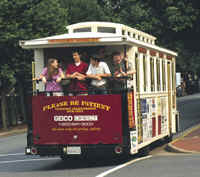
Take
a trolley tour highlighting the city's rich history. |
�Fredericksburg is not a place you
would call a �college town,� but the influence of the University of
Mary Washington is significant,� says Ron Singleton, UMW�s senior vice
president for advancement and university relations.
From student volunteerism to
elder-study programs, UMW has strong ties to the Fredericksburg community.
The 176-acre campus, complete with a community jogging trail, has been
ranked by college guidebooks as one of the nation�s most beautiful.
Singleton notes that more than 300 lectures, concerts and special events
are held on the UMW campus each year, nearly all of which are open to the
community.
The university�s art, drama and
musical offerings contribute to Fredericksburg�s thriving cultural
scene.
�One thing that has surprised me
during the two years I�ve been here is both the quality and quantity of
local artists,� says Holder, the city tourism director. �Both the
visual and performing arts are very good and growing. This is something we
need to capitalize on. I think it adds another element to the appeal of
the city for both visitors and other artists.�
If there is such a thing as the
�voice of Fredericksburg,� a good case could be made for Brian Strobel,
who has been the morning DJ on popular radio station WFLS-FM for almost
three decades.
�I think one of the reasons I have
stayed in Fredericksburg these many years is that I grew up in a small
town [Hornell, N.Y.] and I wanted to continue to live in that kind of
atmosphere,� says Strobel. �Even though the Fredericksburg area has
grown so much, the city has retained its small-town charm. I really like
the fact that I see so many people I know every day in town and get a
chance to chat and feel like a part of a community. I don�t feel
swallowed up like I would in a big city. And this is a great place to
raise a family.�
FUN FACT: The Fredericksburg
Agricultural Fair is billed as the �Oldest Fair in America.� Held in
late July, it will have its 268th anniversary in 2006.